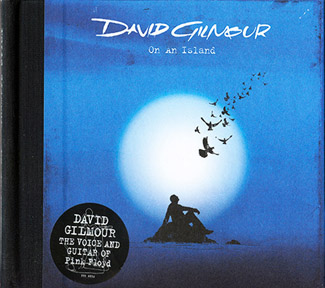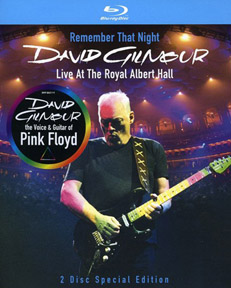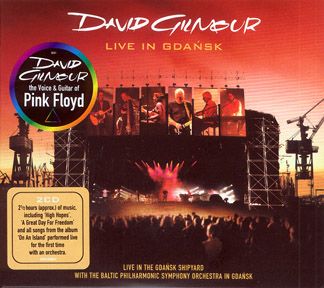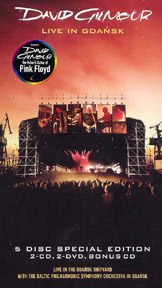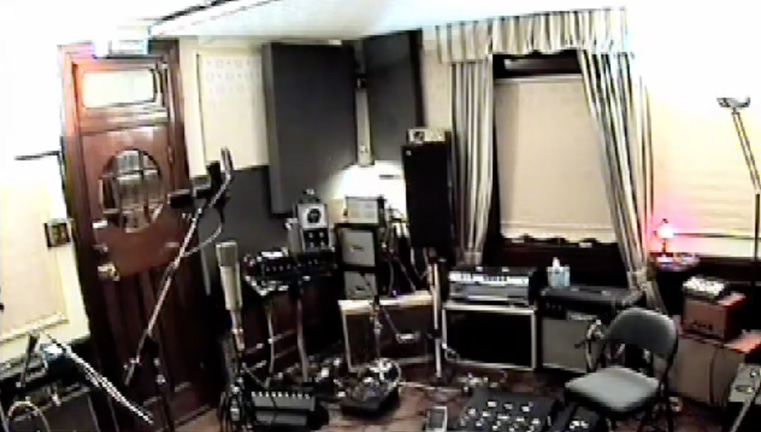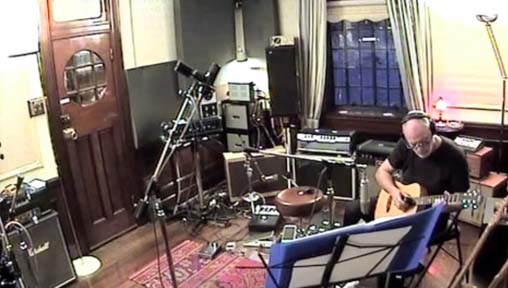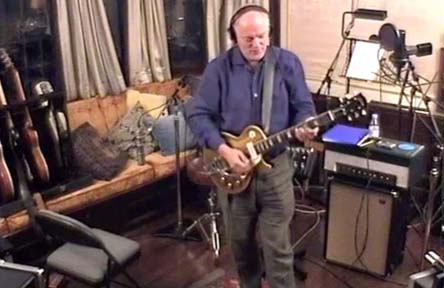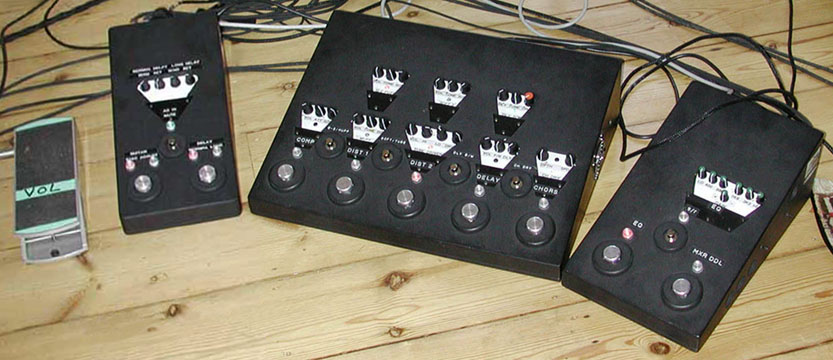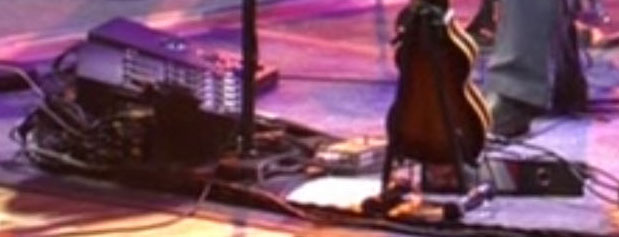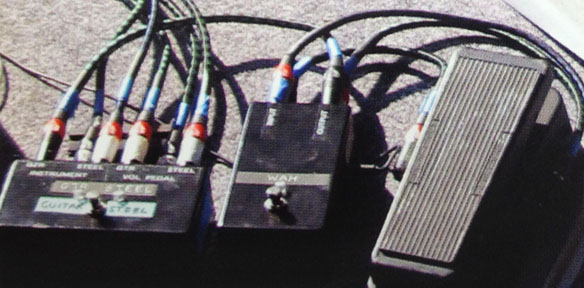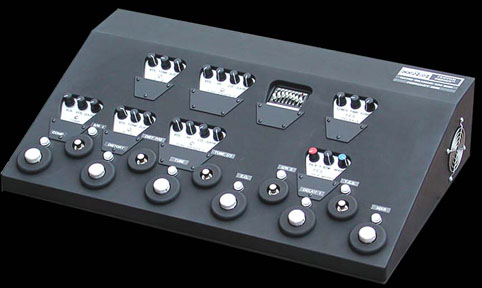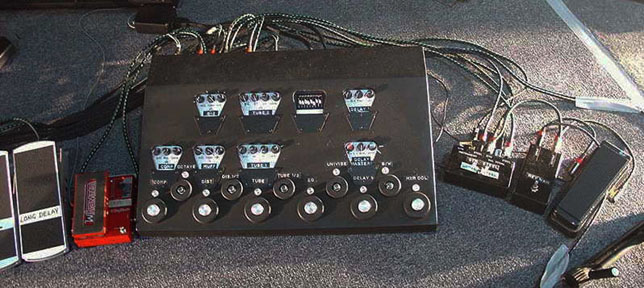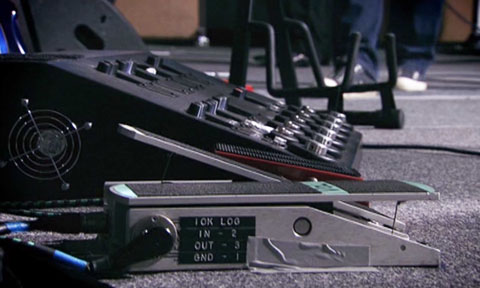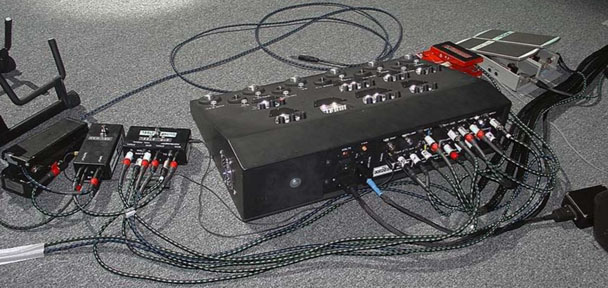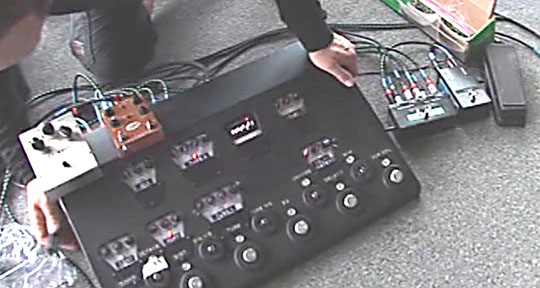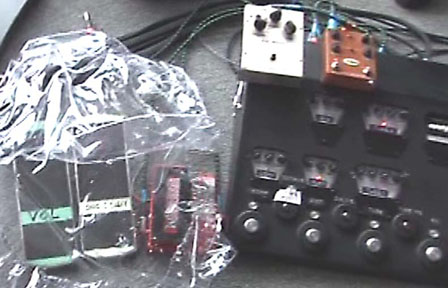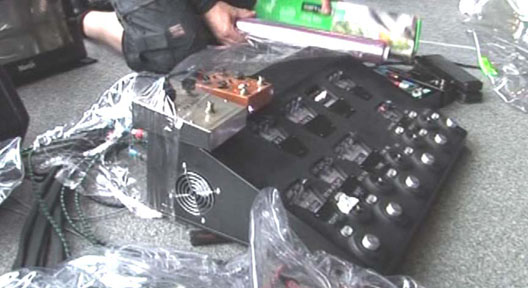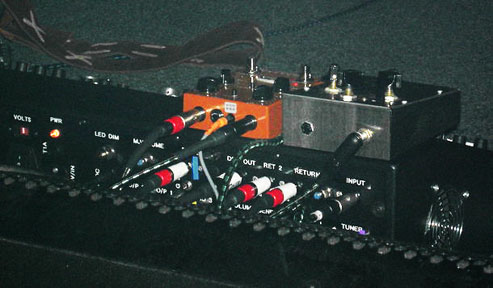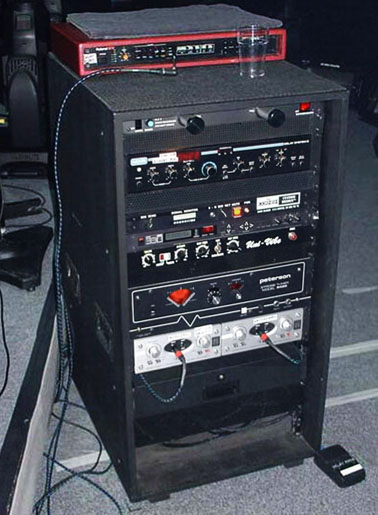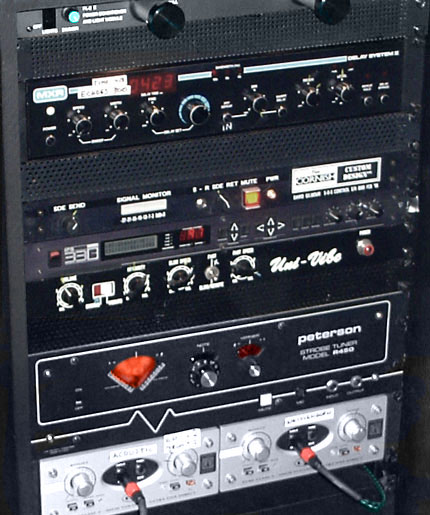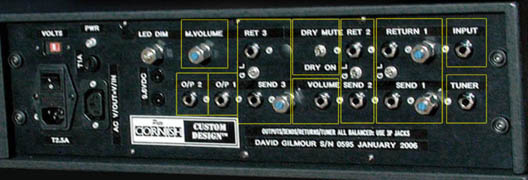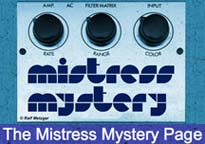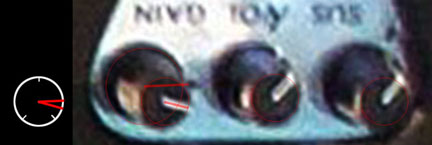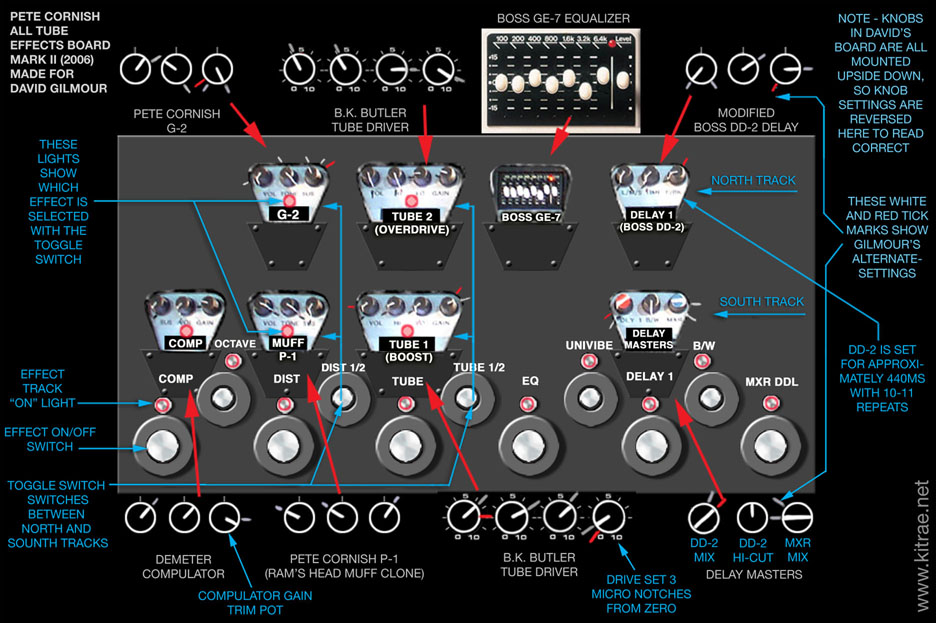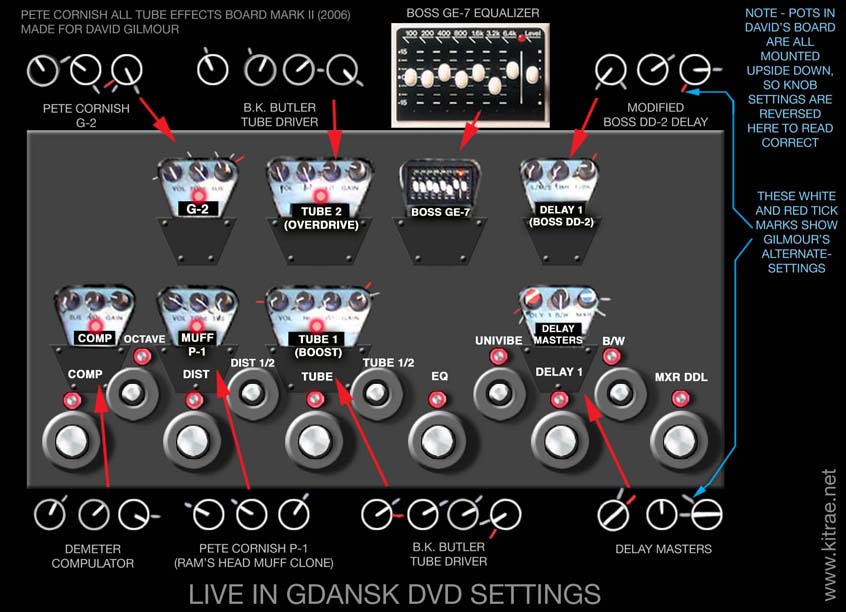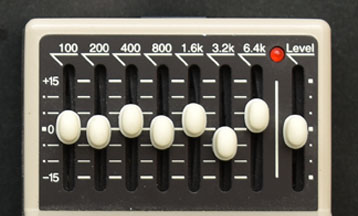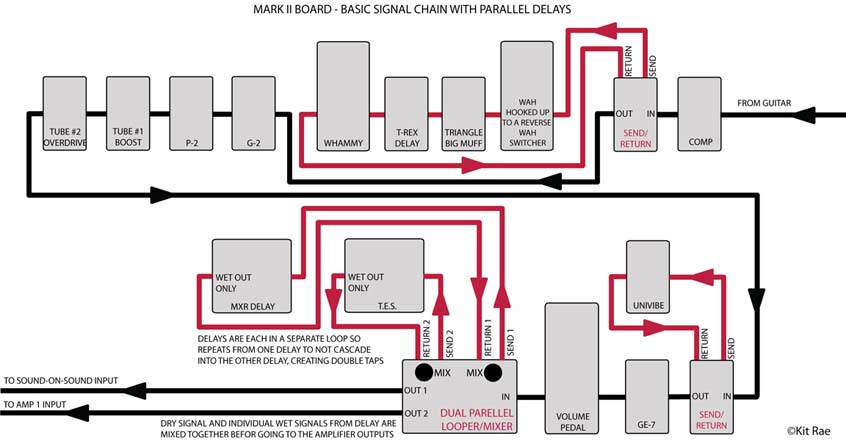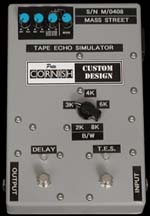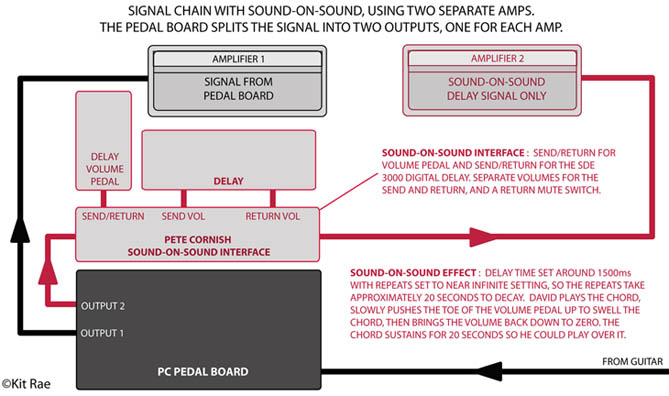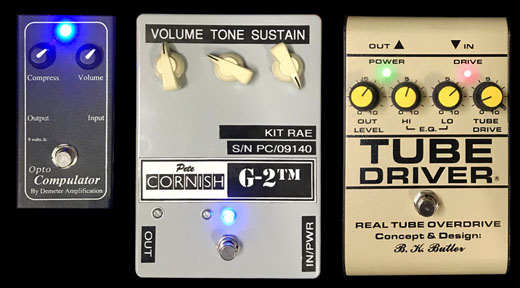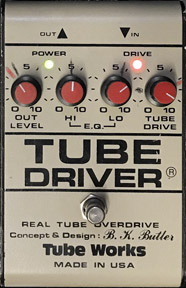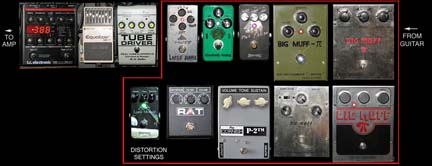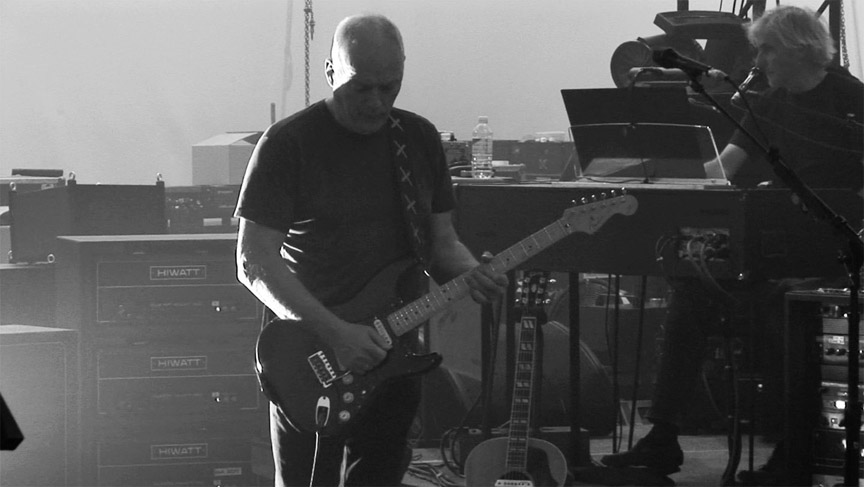NOTE: This website is frequently updated. Last update December 2023
For effects settings CLICK HERE
For my setups and sound clips CLICK HERE
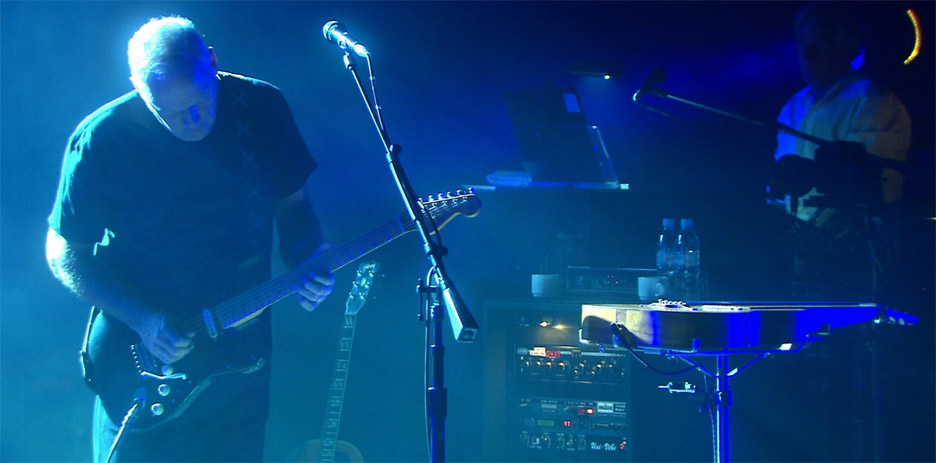
ON AN ISLAND - In 2006 David Gilmour's third solo album, On an Island, was released. It added some new guitar tones to the Gilmour repertoire and gave us some great songs and several incredible guitar solos. David's live performances during the OAI tour, featured in the Remember That Night DVD concert video and the Live In Gdansk CD and DVD/BR concert video, were full of stellar performances and showcased his playing in top form. I like the tones from the tour slightly more than what I hear on the studio recordings for On and Island, but the studio recordings feature some guitar work.
On and Island CD, Remember That Night DVD, Live In Gdansk CD, and Live In Gdansk 5 Disc DVD/CD Special Edition
The most noticeable change from David's last album of new work, 1994's the Division Bell, was the near absence of modulation to color his guitar tones. This was a stark contrast to much of his previous work which featured chorus, flanger, vibe, and other modulations. David's trademark wet delay sound however, was still present, and he continued to rely heavily on the Tube Driver for most of the guitar sounds. On an Island had a softer, more relaxed feel to it than most of his previous work, but there were still plenty of overdriven and distorted guitar solo tones, especially on the subsequent tour. Those of us who follow his work have always known that his trademark sound was not created by the various effects and processing used, but by his fingers. I think this album and tour proved that more than any other.
David's tour setup this time around was rather simple. He had four overdrive/distortion pedals in his board - two B.K. Butler Tube Drivers, a Pete Cornish G-2, and a Cornish P-1. Later in the tour a Triangle Big Muff was added on top of his pedal board. His trusty B.K. Butler Tube Drivers were the primary drive and distortion pedals for the tour. David used two identical Tube Drivers, one set for high gain and one for a light overdrive and to blend with the Big Muffs. Below are comparison sound clips of each of these pedals for reference, with a Ram's Head Big Muff in place of the P-1. Clips play in this order: BK Bulter Tube Driver, Ram's Head Big Muff, Pete Cornish G-2.
TUBE DRIVER, RAM'S HEAD BIG MUFF, G-2 COMPARISONS
ON AN ISLAND STUDIO EFFECTS AND GEAR - OAI was made up of recordings spanning from 2001-2005. Most of David's guitar parts were recorded on his floating recording studio, the Astoria, on the River Thames in London, and other parts were recorded in The Barn studio at his home in Sussex. Among the gear David used was his custom all-tube MK1 pedal board, built by effects gear master Pete Cornish in 1999. The MK1 included a Demeter Compulator (compressor), Pete Cornish G-2, Electro-Harmonix Ram's Head Big Muff, Pete Cornish SS-2, BK Butler/Chandler Tube Driver, Pete Cornish T.E.S. (modified Boss DD-2 and a Tape Echo Simulator), and a Cornish Custom Stereo Chorus (modified Boss CE-2). David aslo used a Digitech Whammy WH-1, and an MXR Digital Delay System II.
Everyone asks what reverbs David uses, and the answer is none! He uses delays, and it's usually around 700 milliseconds or so. That's on his pedalboard, but apart from that there's probably only one or two different distortion boxes and maybe a compressor. It's not that complex, it's just finely tinkered with and he's got some nice guitars and good fingers. The amp was generally an old Fender Tweed Twin...with a little bit from his Hi-Watts occasionally. - Andy Jackson from Sound On Sound July 2006
One of the cramped recording rooms on the Astoria floating recording studio. Among the numerous amplifiers are a Fender Tweed Twin-Amp,
a Fender Bandmaster head on a 2x12 cabinet, a Hiwatt SA-212 combo, and a 20w Bluetick Coonhound amp with a matching cabinet
David used various guitars, including the Black Strat, a 1956 gold top Les Paul with P90 pickups, a Gretsch Duo Jet, a Gibson EH-150 lap steel, and a Hawian-style Weissenborn acoustic slide guitar. He also used a cumbus, a 12 string Turkish instrument. He used a wide variety of amps, but most of the guitars were recorded through an old Fender 40w Tweed Twin-Amp, with other parts recorded through a Hiwatt SA-212 50w combo amp. Other amps can be seen in the Astoria recording studio Pocket Full of Stones security video snapshots shown below, including an early Marshal head that appears to be a 1963-64 JTM45, an Alessandro Bluetick Coonhound, and a Fender Bandmaster head.
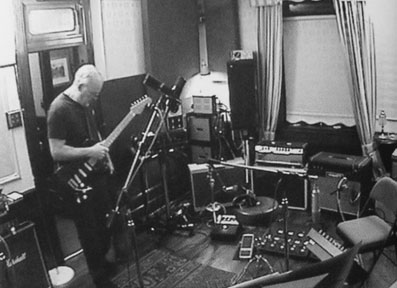
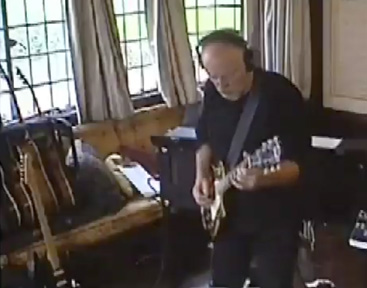
David recording On and Island on the Astoria with his Black Strat and Pete Cornish Mk1 pedal board (left)
David playing the solo for A Pocket Full of Stones solo with his 1959 Les Paul gold top on the Astoria (right)
David recording On and Island on the Astoria floating recording studio. Note the Mk1 pedalboard
and Big Muff on the floor (left photo) and the early 1960 Marshall amp head (right photo)
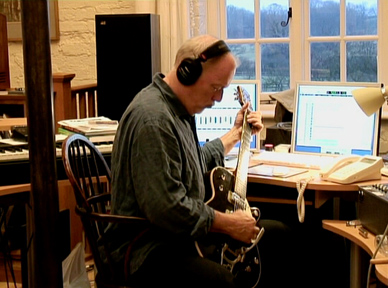
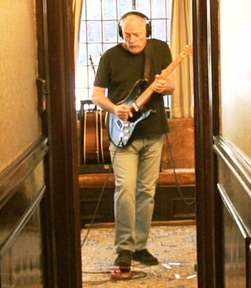
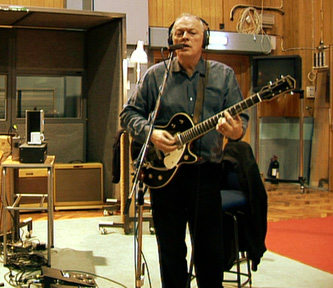
David playing Where We Start in the Barn studio, The Blue solo with Whammy on the Astoria, and recording The Blue backing track at Abbey Road Studios

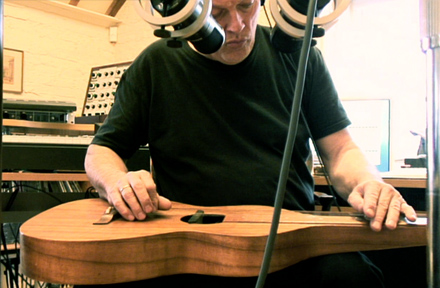
David playing slide guitar on his Gibson EH-150 lap steel through a Fender Twin-Amp for Take A Breath on the Astoria,
and playing a Weissenborn acoustic slide guitar for Smile in the Barn studio, in Sussex
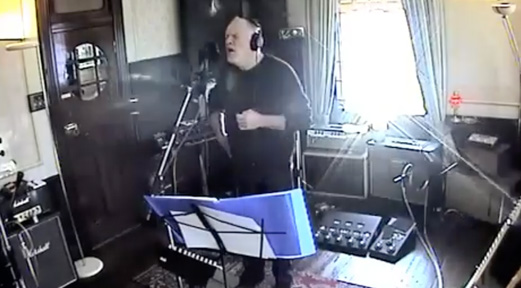
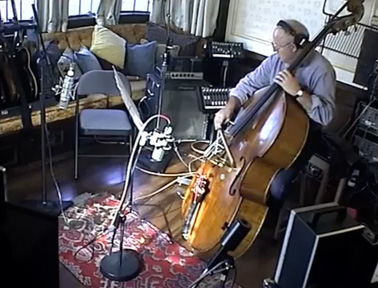
David recording parts for A Pocket Full of Stones on the Astoria
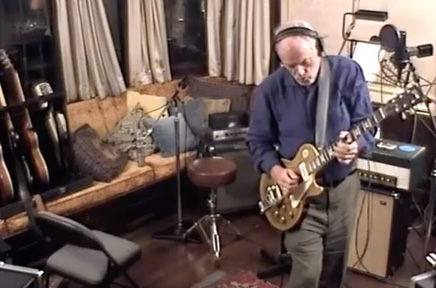
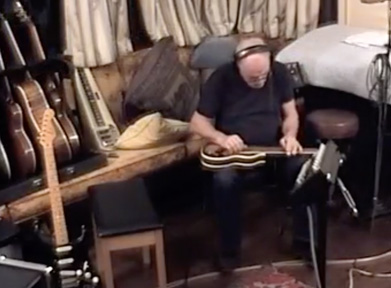
David recording A Pocket Full of Stones on the Astoria with his '59 Les Paul, an early Marshall amp head behind him (left), and Gibson EH-150 lap steel
David began playing custom made Alessandro amps around this time. These were very expensive, hand-made amps that cost around $5000, but one made with the same exotic parts as in David's amps cost around $10,000 (at the time I wrote this article). David's very first Alessandro amp was a 20w Bluetick Coonhound with a matching 2x12 speaker cabinet. He has acquired many other Alessandro amps since then, but I believe the amp seen in the Astoria recording sessions is the original Bluetick. George Alessandro said David uses the Bluetick for studio recording and a Redbone Special when he plays live. This paricular Alessandro amp is housed in a slightly smaller wood enclosure than David's other Alessandros. The volume and tone knobs on the front are not labeled, so David has at times placed tape on the front to label them. It is unclear if anything from OAI was recorded with one.
David was seen using this Alessandro amp again, along with two Alessandro Redbone Specials, when he performed with Jeff Beck in 2009. David said he used the Bluetick to record the solo for Louder Than Words in the 2013-14 sessions for Pink Floyd's The Endless River album. It was seen again in David's barn studio for the Hey Hey Rise Up Pink Floyd video recording in 2022.
David's electric guitar solos were all done in November (2005), which was the last month of recording. He left the electric stuff to the last moment, and I wasn't sure he wasn't going to do it at all. So I was very pleased that we managed to get him back onto the electric guitar, and he put some great things on. - Phil Manzanera, Sound On Sound July 2006
I try to live with the track for quite a long time before I even touch a guitar that's going to play a solo on it. When I'm working at home, it's very easy to just pick up a guitar, not work on a sound very much, and just play a little bit. At first, I find myself loving what I do that way, but ultimately I think it’s not too good and want to change some bits. But then I find myself not able to match the sound of the original solo, or sometimes wishing for a better sound. For that reason, when I go for a solo, I try to make sure the sound is really together and well thought out, because very often the first take is the best take. Except when you try to plan it that way. Then you're still struggling with the same damn solo three days later. .- David Gilmour, Guitarist May 2006
There is not much documentation about the gear or effects used for each song on On An Island, but David has talked about what he used on a few of the tracks, and some gear can be seen being used for various songs in video recordings of the Astoria sessions. David used his Black Strat for Castellorizon. For the first part of the first solo on the title track he used his Les Paul, recorded at his barn studio. For second part of the first solo he used the Black Strat and a Tube Driver, recorded on the Astoria. He tried playing the solo through his Fender Tweed Twin combo amp, but in the end he used his trusty his Hiwatt SA-212 combo amp. For the outro solo he also used the Black Strat and Hiwatt.
He played a Fender Telecaster on Take A Breath, a Gibson EH-150 lap steel on This Heave, Take A Breathe, and Pocket Full of Stones, and a Weissenborn slide guitar for the acoustic slide guitar parts in Smile and Then I Close My Eyes, tuned to open Em (E B E G B E). He used his Gretsch Duo Jet for Where We Start and Then I Close My Eyes. For the intro to Then I Close My Eyes he used a 12 string Turkish cumbus. He used the '56 Les Paul for both the Pocket Full of Stones and This Heaven solos.
I think that most of the high gain solos were likely played using a Tube Driver, but the OAI outro solo sounds like it may be a Big Muff to me. For a Pocket Full of Stones an e-bow effect can be heard, and a tremolo effect can be heard on Take A Breath. A Tube Driver was used for The Blue, with a Digitech Whammy used for the pitch bending effect.
I don’t use the Big Muff or the Fuzz Face as much anymore. I currently have two BK Butler Tube Drivers on my pedalboard, and I just use one or the other. If I need a little something more, I’ll stomp a compressor with a bit of drive onto the beginning of it, and that will turn things up another whole gear - David Gilmour in 2006
That one (OAI outro solo) was my old black Strat...through a Hiwatt combo. I've got a very old Fender tweed Twin--a lovely-sounding amp that I do quite a bit of things on-but I couldn't make it work for that track, so I went to the Hiwatt instead. I have a Hiwatt combo and a Hiwatt lOO-watt head and 4x12 cab in this room (on the Astoria). It's a bit of a problem. A 100- watt Hiwatt doesn't really like being in a close space like this. So setting the right amp that really likes the room it's in is very tricky - David Gilmour, Guitarist 2006
Some of the guitars would be from David's home recording, as he has a similar amp and effects setup at home...the guitar solo for 'On An Island', where there are two guitars, the first is a Les Paul and the second one a Strat. He recorded the Les Paul at home ( the Barn studio) using the Sony mic and I recorded the Strat in the studio (Astoria) using the SM57 and the Coles ribbon (Coles 4040).- Andy Jackson from Sound On Sound July 2006
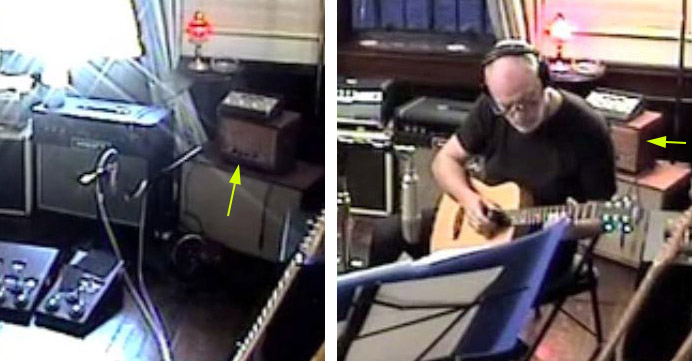
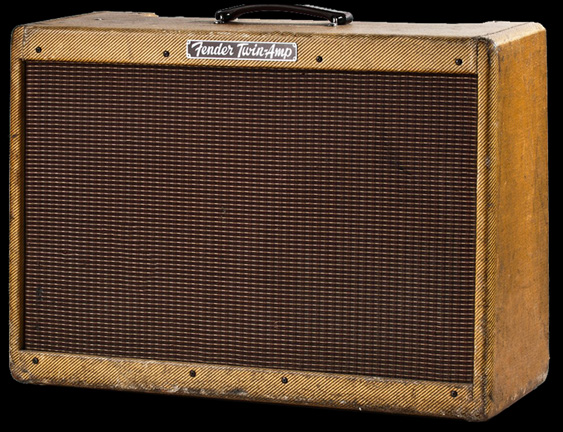
David recording On and Island on the Astoria. Note the small Alessandro amp and 2x12 speaker cabinet on the left. I believe this
is David's very first Alessandro amp, a 20w Bluetick Coonhound. On the right is a and a Fender 1956 Tweed Twin-Amp like David's
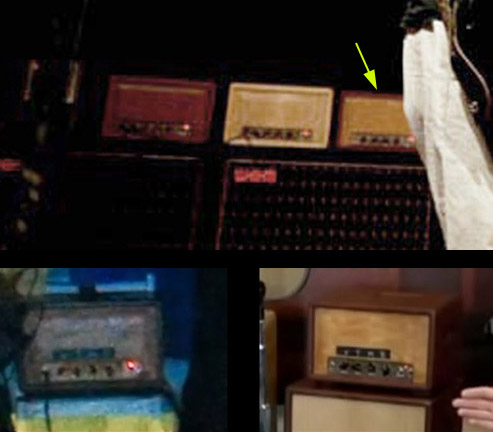
The same Alessandro amp seen in the OAI studio recordings was later used for a Jeff Beck concert in 2009 (top photo)
and then again in 2022 for the Hey Hey Rise Up Pink Floyd recording in David's Barn studio (bottom photos)
David's Mk1 all-tube pedalboard custom built by Pete Cornish in 1999 (photo © Pete Cornish)
David's Mk1 all-tube pedalboard from David's 2001-2002 solo performances
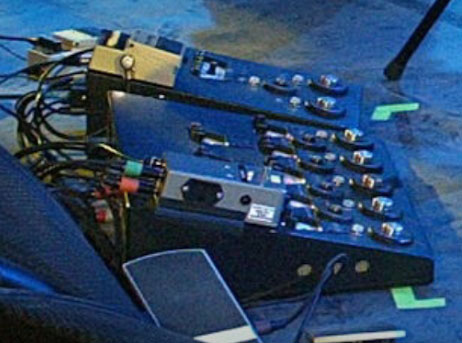
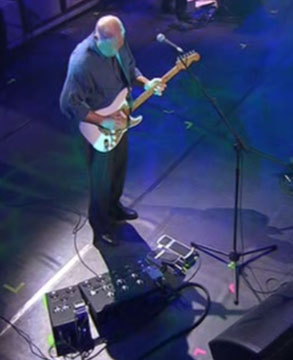
David's Mk1 all-tube pedalboard from the 2004 Strat Pack Concert
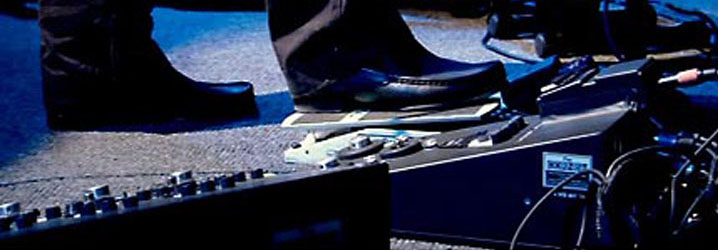
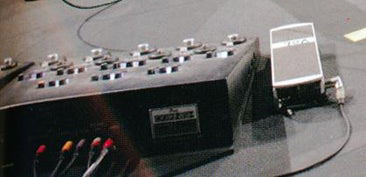
David's Mk1 all-tube pedalboard from 2002 and 2005
The Mk1 pedalboard featured custom designed and built unity gain tube pre-amps between each effect, allowing each to perform as if it were connected directly to the amplifier. There was a stereo tube line driver and two sets of isolated stereo outputs (four in total) to allow two to four amps to be connected for a stereo rig, or just a single amp. The Mk1 was used for many of David's guest guitarist performances, such as the Cavern Club concert with Paul McCartney, as well as David's solo concerts from 2001-2002, the Strat Pack concert in 2004, and the Pink Floyd Live 8 reunion in 2005. Below is the signal chain from Pete Cornish.
THE CORNISH MK1 ALL-TUBE PEDALBOARD SIGNAL CHAIN
Main Mk1 Board:
Pete Cornish Tube Buffer
Demeter Compulator - this replaced the Boss CS-2 in 2004
Send / Return #1 - added in 2004 for David's Digitech WH-1 Wahmmy pedal
Pete Cornish G-2 - warm, Germanium sounding overdrive based on the Big Muff circuit. Used with Tube Driver #1.
Electro-Harmonix Big Muff - vintage "Ram's Head" Big Muff. Used with Tube Driver #1.
B.K. Butler Tube Driver plus Pete Cornish Tube Buffer - Set for a light drive. Note that the Tube Drivers follow the Muffs in the signal chain.
Pete Cornish SS-2
Custom Volume Pedal insert - for David's Ernie Ball volume pedal. Used to control volume before the signal hits the delays.
Pete Cornish Tape Echo Simulator with Pete Cornish Tube Buffer - This is a customized Boss DD-2
2X Outputs with Cornish Tube Line Drivers
Pete Cornish Custom Stereo Chorus - modified Boss CE-2 chorus
2X Outputs with Cornish Tube Line DriversSatellite Board #1
6 Channel Tube EQ
Spare Send-Return for additional effects if required - used for GE7 (2004) and Univibe (2005)
Send-Return for MXR DDLSatellite Board #2
Electric - Acoustic Guitar Selector
Send-Return for MXR DDL - linked to Satellite Board #1
Send-Return for Long Delay - for Sound on Sound using Roland SDE 3000 delay
Acoustic DI Mute
_________________________________________________________________________________________________________
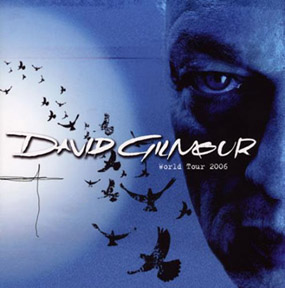
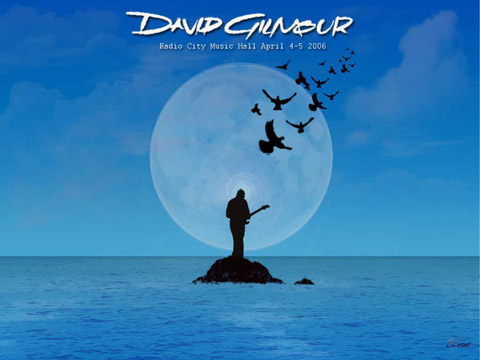
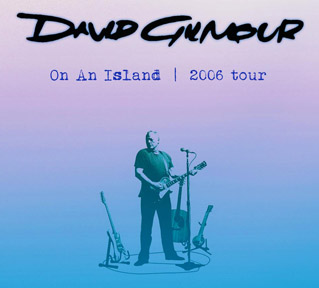
ON AN ISLAND TOUR LIVE SOUND - The mixes of the On an Island official live recordings at various venues differ in tone from each other quite a bit, but you will notice all have a more direct, in your face tone than the studio recordings, with practically none of the modulation from previous tours. Below are reference clips of Gilmour guitar solos from the studio recording and various live performances.
GUITARS, AMPS, SPEAKER CABS USED FOR THE TOUR - David's primary guitar for the live concerts was his Black Stratocaster. He also used a '56 gold top Les Paul with P90 pickups, his '57 reissue Red Strat with EMG-SA pickups, '58 Gretch Duo Jet, '50s reissue Telecaster, Jedsen lap steel with EMG-H pickup, Fender Deluxe lap steel, and several acoustic guitars. His main amps for the OAI tour were two 1974 Hiwatt DR-103 100w heads. He also had a third DR-103 for the Sound-on-Sound rig. These are the amplifiers heard in the Mermaid Theatre and Remember That Night live concert videos. The live sound (including Live in Gdansk) changed for the European leg of the tour when David added an Alessandro amp to the rig, as I explian later in this article.
For speaker cabinets David used three WEM Super Starfinder 200 4x12" cabinets. Two were used with his main Hiwatts, one loaded with Fane Crescendo speakers and the other with 75 watt Celestions. Possibly the Rola Celestion G12/75s or 1980s-1990s G12T-75 speakers. The third WEM was used for the output of the Sound-on-Sound rig. Everything was connected with Evidence Audio cables.
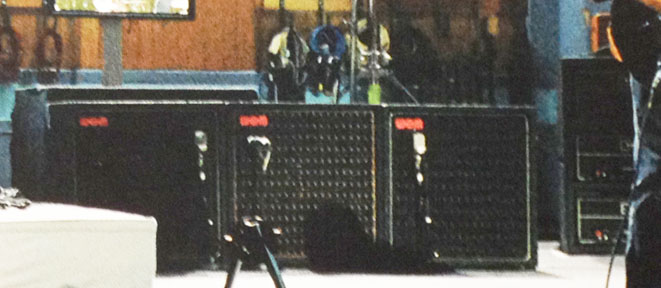
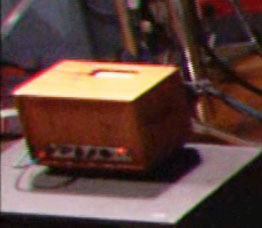
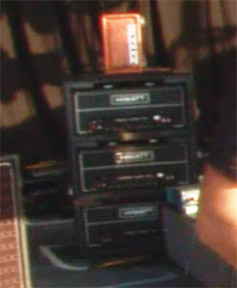
On the left are David's three WEM Super Starfinder 4x12 speaker cabinets. Middle photo is an Alessandro Redbone Special amp head in a brown wood enclosure.
This was added for the European shows and can be heard on the final show in August 2006, recorded for fantastic Live in Gdansk album and concert video.
Right photo is David's Hiwatt amp stack with the Alessandro on top
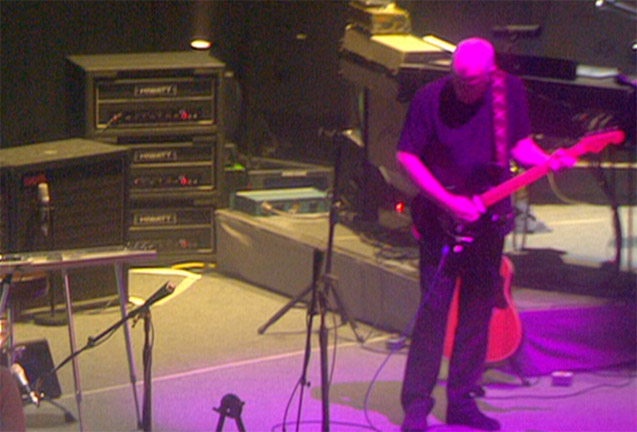
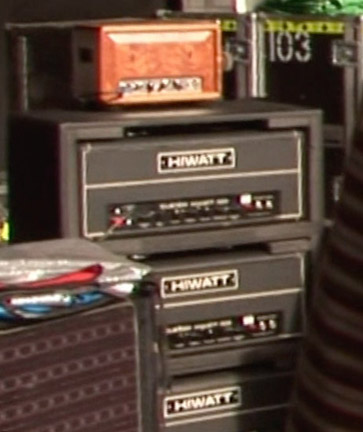
On the left is David's amp stack from May 2006, with three 1974 Hiwatt DR-103 100w heads.
On the right, on top the the Hiwatt stack, is a custom voiced Alessandro Redbone Special amp head in a brown wood enclosure.
ALESSANDRO REDBONE SPECIAL - A custom voiced Alessandro Redbone Special amp built by George Alessandro was added for the European leg of the tour. It could be seen on top of his amplifier stack. This is often mis-identified as a 20w Alessandro Bluetick model, but George Alessandro confirmed this is his Redbone Special.
The Alessandro Redbone Special is a hi-end 2 x 6550-based power amp with a 3 x 6SL7-type (all-octal) preamp. The RBS sound has been described as having cleans like a 50w plexi Marshall Super Lead mixed with a compressed Fender tweed amp, with Marshall plexi-like overdrive at high volume. George Alessandro first began making the RBS in 1996, and only a small number are in existance. The amp produces a superb clean tone and smooth overdrive with rich harmonics. The EQ controls are very sensitive and versatile. As with all Alessandro hi-end amps, they are housed in hand-made cabinetry built of various fine woods like mahogany, walnut, flame maple, and cherry. David owns several and each has a different wood cab.
George told me the RBS he made for David is not the same as his standard RBS amp, which had a little too much preamp gain. David wanted a slightly cleaner preamp, so a 6SN7 tube was used in the phase inverter. It is still a clean amp, but the lower gain does not start to distort until farther up on the volume control, so David could have it louder and still be clean. The RBS powered one of the WEM speaker cabinets, likely the one with the Celestion 75 speakers inside. The rig sound was a blend of the Alessandro and Hiwatts, but the Alessandro seems to be the dominant amp in the mix, as heard in the Live In Gdansk concert video and live album. This amp combination has a distinctly different sound than the Hiwatt-only rig heard in Remember That Night.
For David's 2015/2016 tour he also used the Redbone Special/Celestion speaker and Hiwatt/Fane Crescendo combination.
_________________________________________________________
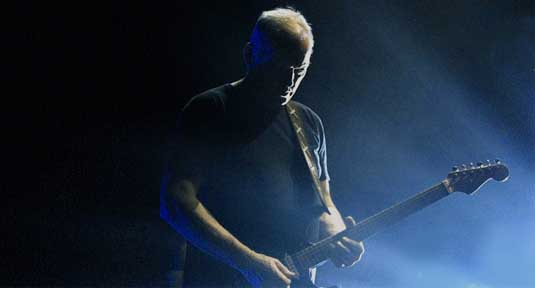
ON AN ISLAND TOUR EFFECTS - For the On An Isand tour David used a new tube buffered pedal board built by Pete Cornish, nicknamed the Mark 2. This was a revised and simplified version of his previous Mk1 effects boards, and included all the primary effects needed to replicate the various songs in the set list, including the entire OAI album. As with the Mk1, the Mk2 featured unity gain, all-tube buffering. A tube buffer presents a high impedance load on the input to prevent signal loss and loading from the previous circuit, and sends a low impedance load on the output. This avoids loss to the audio signal, mimicking the sound benefits of plugging directly into an amp. The buffer system included seven low power, twin-triode tubes, which have two triodes cascading together to create an amplifier, and a low output impedance. There were also built in line drivers that send a low output impedance signal with a high current output to help "drive" the signal over long cable runs.
Placed in line before the Mk2 board was a custom Pete Cornish wah bypass looper and a guitar switcher interface. David also had a rack of effects liked to the Mk2 board via a send/return. The rack included an MXR Digital Delay System II, Digitech IPS 33B Super Harmony Machine, a custom rack-fitted Univox Uni-Vibe, and the Pete Cornish Sound-on-Sound interface connected to a Roland SDE-3000 delay. The entire rig was connected with Evidence Audio cables. The signal routing of the switcher interface was changed slightly during the tour.
(shown bove) The Pete Cornish Mk2 pedalboard after it was completed and the board on stage with the rest of David Gilmour's floor rig, using
Evidence Audio cables. The rig consists of (left to right) customized Ernie Ball volume pedal, second volume pedal for Sound-on-Sound effect,
Digitech WH-1 Whammy, Cornish Mk2 board, Cornish guitar interface/switcher, Cornish wah bypass looper, and Dunlop Wah Wah.
(shown above) Gilmours main Ernie Ball volume pedal, modified with a 3-pole XLR socket and a 10k log pot. It was fitted with an Evidence Audio Lyric HG
cable functioning as a TRS, so only one cable was needed to both send and return the signal to and from the volume pedal. This was plugged into the guitar
interface (small black box with six jacks on left) and that was plugged into the volume jack on the back of the Mk 2 board.
ON AN ISLAND EFFECTS - For the OAI tour and other live performances from this era David had two B.K. Butler 911 Tube Drivers, a Pete Cornish P-1, and Pete Cornish G-2. Tube Drivers are overdrive pedals, but they can also do high gain distortion. One Tube Driver was set for a low gain clean boost and the other for high gain overdrive. Both were newly made reissues of the 1990s era 911 Tube Driver, which was slightly different than the old BKB/Chandler Tube Drivers David used for the 1994 Pink Floyd tour. The high gain Tube Driver was used for nearly all the heavy leads, including most of the performances of Comfortably Numb.
"He has always had two (Tube Drivers) in his guitar setup, since '94, one set on minimum gain, the other more. During most of the On An Island Tour in 2006 he used the second one instead of using a Big Muff (P-1) in Comfortably Numb, giving a different character of sound." - Phil Taylor, Guitar tech for David Gilmour - June 2018 issue of Tonequest
The P-1 is a high quality 1970s era "Ram's Head" Big Muff Pi clone. It was probably only used for some performances of Comfortably Numb and the Time solos on the tour. The G-2 is Big Muff-based circuit with a lower gain overdrive-like tone. It sounds like a mid range focused overdrive mixed with a warm germanium fuzz-distortion tone, sort of like a Big Muff blended with a ProCo Rat distortion. Contrary to popular belief, the G-2 was probably used very little on the tour, if at all. I have never seen a video or photo of the pedalboard from the 2006 tour showing the G-2 LED activated. There are times I think it may have been used, like some performances of Take A Breath. It was removed from the board several years after the tour.
David also used a Demeter Compulator compressor, a Boss GE-7 equalizer, a Digitech Whammy, a custom rack mounted Univibe, a Cornish modified Boss DD-2 digital delay with T.E.S. (tape echo simulator) circuit, and an MXR Digital Delay System II rack unit. Note that David's signature modulation effect, the Boss CE-2, does not appear in this board. David's only modulation for this tour was the external rack mounted Univox Univibe.
Just before the second half of the European leg of the OAI tour David added a Triangle Big Muff and a T-rex Replica delay together in one loop using one of the Mk2 board send/returns. David was seen testing his DG Original Ram's Head Big Muff and a Triangle Big Muff in the Bray Studios rehearsals, and apparently he decided on the Triangle. It was re-wired to used a single 3-pole jack, so the input and output could be combined in one TRS cable rather than two separate cables.
The triangle and the Replica delay were likely used for the distortion leads played during the funky part of Echoes, where it was necessary to repeatedly turn delay and distortion on and off simultaneously. When David was asked how he got the lead tone on the live version of Echoes (Guitar Player, Janyary 2009) he said "That probably is a Big Muff". He may have been referring to the Triangle or the Cornish P-1.
(shown bove) David's original Big Muff (with DG ORIGINAL label), a Triangle Big Muff,
and T Rex replica delay on top of his tour board at the Bray Studios rehearsals in 2006.
(shown bove) The Mk2 version of the Pete Cornish custom all-tube buffered pedal board with Triangle Big Muff and a T-rex Replica delay
pedal added for the second half of the European leg of the tour. These were likely used for the song Echoes.
(shown above) The Triangle Big Muff was re-wired to used a single 3-pole jack, so the
input and output could be combined in one TRS cable rather than two separate cables.
(shown above) Gilmour's rack effects - Roland SDE-3000 delay (shown on top of rack) for Sound-on-Sound
Furman PL-8 Power Conditioner
MXR Digital Delay System II
Pete Cornish Sound-on-Sound interface
Digitech IPS 33B Super Harmony Machine
custom rack-fitted Univox Uni-Vibe
Peterson Strobe Tuner model R450
THE CORNISH MK2 PEDALBOARD SIGNAL CHAIN - Below is the Mk2 signal chain from the Pete Cornish website, with my additonal notes about how spme of the routing was done and how certain effects were used.
Guitar - The guitar is plugged into the Wah Bypass box.
Wah Bypass - The Dunlop Wah Wah pedal (only used for Echoes) is plugged into a loop in the bypass box. The output from this box is then sent to the GTR input of the Guitar Selector.
Guitar Selector - This is a custom 6 jack switch box that selects between David's guitar or his steel slide guitar. It included a guitar input jack from the Wah Bypass box, a single volume pedal jack for both the send and return from the volume pedal, a second guitar jack, two steel guitar jacks, and an instrument jack that sent the signal to the Mk2 input.
Input with Pete Cornish Tube Buffer - unity gain tube input buffer.
Demeter Compulator
Send / Return #1 - for additional effects. Gain trim pot for instrument or line level interface, with Cornish line driver on return. David ran the Digitech WH-1 Wahmmy pedal through this. This also must be the S/R he ran the Triangle Big Muff and T Rex delay through later in the tour. Both were mounted on top of the Mk2 board.
Pete Cornish G-2 - warm sounding overdrive (aounds like a Big-Muff-mixed-with-a-Rat). Used with Tube Driver #1.
Pete Cornish P-1 - vintage "Ram's Head" Big Muff clone (sorry Pete - I know you don't like your pedals to be called clones). Used with Tube Driver #1.
2 X B.K. Butler Tube Driver plus 2 X Pete Cornish Tube Buffer - One set for a light drive and one set for overdrive. Note that the Tube Drivers follow the Muffs in the signal chain.
Send / Return #2 - for additional effects. Instrument level fixed gain. David ran the Univibe in his rack through this s/r.
Boss GE-7 equalizer
Custom Volume Pedal insert - used to control volume before the signal hits the delays. David's Ernie Ball volume pedals are customized with 3-pole XLR jacks. This is to allow one cable to both send the signal to and from the volume pedal.
Pete Cornish Tape Echo Simulator with Pete Cornish Tube Buffer - David uses echo delay for practically everything. This is a customized Boss DD-2, a very versatile, warm sounding digital delay. Dry signal removed and wet signal mixed parallel with original signal. The setting shown in the Kodak theater photos shows a 440ms delay.
Send / Return #3 - for additional effects. Gain trim pot for instrument or line level interface. Cornish line driver on the send and return. David ran the MXR Digital Delay (in rack) through this send. Dry signal removed and wet signal mixed parallel with original signal.
Dry On/Dry Mute selector switch - This mutes the dry signal in the wet/dry mixer stage before the two outputs to the amps. When muted, only the delayed signal from the two delays is heard. Used to check the isolated wet delay signal.
Output 1 - with Cornish Tube Line Driver. Sent to Hiwatt DR103 amplifiers.
Output 2 - with Cornish Tube Line Driver. Sent to the Sound-On-Sound interface, then to a volume pedal and returned to the interface, then to an SDE 3000 delay, and into a Hiwatt DR103 amplifier
The back of the MK2 Pete Cornish pedal board showing the 3 send/retun jacks, dry mute switch, and the two amp outputs, one
of which sent the signal to the Sound-On-Sound rig. All of the inputs and outputs were balanced signals using 3-pole cables.
OUTPUT BUFFERS - Note that many effects feature a unity gain tube buffer in the output stage. The net effect of the output buffer is that the signal of each effect pedal circuit is balanced and reacts as it it were the only pedal in line from the guitar before it hits the amplifier.
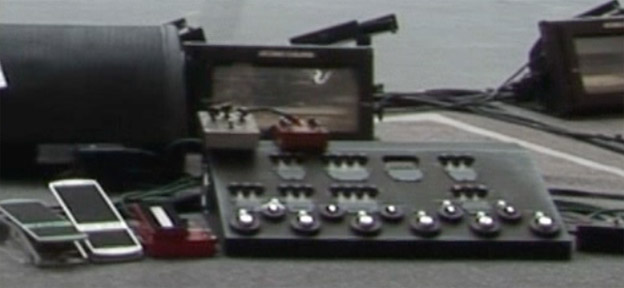
EFFECT SETTINGS - For this tour we were lucky enough to see some actual photos of David's rig with all effect settings shown from the Kodak Theatre performance in 2006. Below is a diagram of the MK2 board with the settings from one of the shows. The effects used for particular songs varied from show to show depending on the venue sound and David's preference at the time, but most of the effect settings likely remained the same for the tour, as indicated by the knob setting tick marks on the board. Also note that the actual board knobs are all upside down (180 degree rotation) from the way they would normally read (according to Pete Cornish from the Tone From Heaven website). This was to make it easier to read the knob indicator lines using the in board LED lights, which illuminate from the bottom. On my diagram below I have also shown the knob settings in the standard orientation.
Gilmour talked about this board in a 2009 interview - "I've got a pedal board that switches to a north track or a south track". North/south just refers to the physical position of effects on the board, not two separate signal chains. It's more like an A/B switch. As I understand it from Pete Cornish, the effects without the north/south toggle switch affect anything when on, whether the distortions or TDs are on in the north or south track. There was a puposeful limitation in the chain that prevented both the G-2 and P-1 distortions from being on at the same time, and both Tube Drivers from being used at the same time, but otherwise David could use any combination of effects.
THE CORNISH MARK 2 BOARD - The switches on the Mk2 board are labeled in this order, left to right:
COMP - Switches the Demeter Compulator on/off. David used the compulator to add compression, but it seems it was also used to add a slight added gain boost for solos. In fact, David had the gain trim pot of the Compulator moved to the top of the board as a proper control knob. According to interviews, David used this to accent certain places in solos, and has been seen often switching it on and off for added effect during live performances. He mostly uses it with his clean neck pickup tones and for his light overdrive tones with Tube Driver #1. The tick mark beside the gain knob was at about 80%, but the actual knob position from one photo is set at 85-90%, which is almost maximum gain in the diagram below.
OCTAVE - This send/return switch is dedicated to the Digitech WH1 Whammy pedal, used for the octave effect in The Blue. This also appears to be the s/r David used for the Triangle Big Muff and T-Rex delay that were in a loop on top of the Mk2 board for the latter half of the OAI tour. That setup was likely used for the funky section of the song Echoes.
DIST - This switched on the selected distortion, P-1 or G-2
DIST 1/2 - This toggles between the P-1 and G-2 Muffs. The P-1 is labeled MUFF, and is very similar to a "Ram's Head" Big Muff. The G-2 is a modded Big Muff that has a warm Marshall type amp tone. Pete Cornish has said both distortions cannot be on at the same time and that David likes to EQ his high gain distortions with low gain Tube Drivers, which we somewhat misleadingly call "boosting." David only boosts with the Tube Driver #1 set for a light drive, not the overdrive TD. It is more of a blend of the two pedals, not a volume boost. The boost setting shown below gives a slight gain/drive boost. It is meant to add some additional gain to the Big Muffs, blending them with the saturation and tone characteristic of the Tube Driver, and using the Tube Driver EQ to sculpt the Muff sound slightly.
TUBE - Turns on the selected Tube Driver.
TUBE 1/2 - Toggles between TD#1 and TD#2 Tube Driver #1 is set for a light boost and #2 set for overdrive. Tube Driver #1 is used when boosting David's Muffs, and for all slightly dirty neck position tones. Tube Driver #2 is for heavy overdrive tones from the Neck and Bridge pickups.
EQ - Turns on the Boss GE-7, seen on the board right side up. According to interviews, David used this EQ pedal to accent certain places in solos. I think it was alwasy used with the P-1, and often used with the high gain Tube Driver, especially when playing Comfortably Numb with the TD.
UNIVIBE - This send/return switch is dedicated to the Univibe, which was a rack mounted external effect.
DELAY 1 - Turns on the moddified Boss DD-2 delay. The settings shown below are for a 440ms, with a rather long feedback of approximately 10 repeats.
B/W (bandwidth) - Turns on T.E.S. Pete Cornish Tape Echo Simulator circuit. Note there is also a b/w mix control in the Delay Masters section. This is a hi cut knob set for 4k.
MXR DDL - This send/return switch is dedicated MXR Digital Delay, which was a rack mounted external effect. The blue knob marked MXR is a mix knob for the external MXR delay.
(shown above) David Gilmour's Mk2 Pete Cornish effects board settings from the Kodak Theatre performance.
Note that most settings also correspond to the tick marks on the board, but David likely adjusts his settings from venue to venue.
(shown above) David Gilmour's alternate settings seen on the live in Gdansk DVD. The Tube Driver #2 and G-2 are the only effects with slightly different settings.
_________________________________________________________
BOOSTING BIG MUFFS WITH A TUBE DRIVER - The G-2 and P-1 pedals are essentially Big Muff circuits, although the G-2 is heavily modified for more of a mids focused overdrive sound. David used his Tube Drivers as a boost/EQ pedal for his Big Muffs for nearly all the high gain distortion solos on Pink Floyd's 1994 Division Bell tour, and this was the case for the On and Island tour as well. When David "boosts", he is not using the drive as a volume boost, but to create a blend of the two pedals, and EQ the sound. When David used his Tube Driver + Muff combination in 1994, the TD nearly always came first in the signal chain before the muff. The only time it came after the Big Muff (or P-2) was for the Time solo. For the On an Island tour, the Tube Drivers always came after the P-1 and G-2 in the signal chain.
David Gilmour likes to have the first inline high gain pedal (G-2 or Muff) "EQ'ed" by the second lower gain pedal so they will virtually always be on as a set: Muff/ Tube Driver, G-2/Tube Driver... - Pete and Lydia Cornish
I experimented with the exact pedal settings shown above, using the exact same pedals David used, and a Hiwatt custom 50 amp. I found that when the Tube Driver #2 with the low drive setting is placed after the Cornish P-1, it simply adds a slight gain boost. There a slight tone coloring of the P-1 sound with the lo and hi EQ settings, and no volume change. The added drive makes the P-1 distortion sound like it is almost to the point of breakup, giving it a slighlty dirtier sound, similar to the way a speaker breaks up with high volume. Some of the buziness of the Muff is also softened. The difference is minor, but it is a breakup the P-1 cannot create on its own through a Hiwatt amp, even when the P-1 sustain is at maximum. I think you can hear this tone on the second On an Island solo from Remember That Night.
The boost effect is slightly different when the G-2 is blended with the Tube Driver. The distortion created by the G2 is not as high gain as a typical Big Muff circuit like the P-1, and the tone is a bit thinner. When blended with the Tube Driver #2, The G-2 drive gets a gain boost, and the tone color smooths out and fattens slightly. One weak point of the G-2, in my opinion, is the low gain, so this combo gives the G-2 a nice amp-like gain boost. The G-2/TD blend is actually very hard to tell apart from the high gain Tube Driver or P-1 sound in a band setting, but the G-2 has slightly more mid range. I think the G-2/TD combo may have been used for the Fat Old Sun solo, Time solo, and Take A Breath solos from Live In Gdansk. Just about everything else sounds like the high gain Tube Driver.
David's 2006 GE-7 settings
THE BOSS GE-7 EQUALIZER - The GE-7 has been a favorite of David's since the 1980s and has appeared in nearly all of his live rigs. In previous rigs David used multiple GE-7s, each with different EQ settings. This time around he only used one, but I think it was an integral part of his live lead sound. The frequencies that can be adjusted on the GE-7 are 100hz, 200hz, 400hz, 800hz, 1.6khz, 3.2khz, and 6.4khz. The settings David used boosted the 1.6k mids and 6.4k highs, but scooped the 3.2k and 800hz frequencies, making the tone slightly fatter and punchier. It makes the high gain Tube Driver sound more like a Big Muff and makes the G-2 sound more like the high Gain Tube Driver. It also made the P-1 sound fatter and more aggressive.
David's EQ settings were almost identical to his EQ#1 settings used for his 2015 tour. He used that GE-7 for most of the high gain and overdrive solos in 2015, so it was likely used for the same in 2006.
_________________________________________________________
PARALLEL MIXED DELAYS IN THE MARK 2 BOARD - The delay system inside and outside the Mk 2 board is very interesting. People always wonder how David gets his smooth delay sounds. David often uses two delays. Stacking one delay after another in your signal chain can degrade your tone because your original signal travels through, and is altered by, two delay circuits before coming out the other end. Also, two delays in line, while useful for some double tap delay effects, means that one delay creates repeats that are then repeated again by a second delay, which can create a messy, mushy delay sound. David's setup in the Mk II board is very different.
Inside the board is a two mode delay. The first mode is a Boss DD-2 digital delay, with controls located in the Delay 1 section. Controls are identical to the old Boss DD-2/DD-3 delay. L/M/S (shown in the board diagram above) represent long, medium, and short delay time modes. David has tick marks for only long and short positions. DTM is delay time. F/BK is feedback, or the number of echo repeats. Knob settings shown above correspond to a Boss DD-2 set at approximately 440ms delay with feedback/echo repeats set at 80%, or around 10-11 repeats. The red knob marked DLY in the Delay Masters section is a mix knob for the DD-2.
The second mode of the delay circuit is the T.E.S. This is meant to simulate the warm, limited bandwidth sound of an old analog tape echo delay by rolling off the high frequencies (hi-cut) gradually wth each echo repeat. The on/off switch for the TES circuit switch is labeled B/W on the board, for bandwidth, and the B/W knob in the Delay Master section is an EQ to control the amount of roll off the TES applies to the DD-2 echo repeats. It appears David has his set for a 4k hi-cut, which is a very dark sound, but I don't think David actually used the T.E.S. feature. The blue MXR knob is a mix knob for the external MXR digital delay.
The Pete Cornish Tape Echo Simulator (TES) delay. This is the stand alone pedal version made by Pete. It is essentially a Boss DD-2 digital delay circuit combined with a five position hi-cut circuit to simulate the limited bandwidth decay of an old tape echo unit, and a Cornish buffer.
There are foot switches to turn the DD-2 delay on (Delay 1), a switch to engage the T.E.S. circuit (B/W), and switch for the external MXR digital delay (MXR). To maintain the best possible signal quality, these delays are mixed parallel with the original signal. This keeps the original dry signal from being altered when running through the delay circuits by splitting off a separate dry signal to each of the delays, while the original dry signal is allowed to run parallel. The three signals - the dry signal, the DD-2/TES signal set for 100% echo repeats only (meaning no dry signal, only the repeats), and an MXR signal set to 100% echo repeats only - are then mixed back together inside the board with the red and blue mix control knobs you see in the Delay Masters section. The unique characteristics of each delay remain intact, and are nicely blended together with the pristine dry signal before they hit the amplifier. David gets the benefits of two delays, each with different delay times, without one delay repeating the other. At times it has the feel of reverb, but without the negative tone altering effect of reverb.
David's MXR Digital Delay System II rack unit from the On an Island tour showing a note for
David's Echoes delay time of 300ms, one for the delay in Time, and 423ms in the display
_________________________________________________________
SOUND-ON-SOUND - David Gilmour had a special Sound-on-Sound (S-O-S) rig built for performing the intro to a new acoustic version of Shine On You Crazy Diamond for his 2001-2002 Meltdown concerts and he used this same rig for his 2006 tour. The S-O-S rig allowed him to play sustained chords on the guitar which he could then play melody on top of. For David's 2006 rig one output from his Mk 2 Cornish-built pedalboard went to his main Hiwatt amp and 4x12 speaker cabinets. The other output went to a Sound-on-Sound interface built into David's rack, which fed a second Hiwatt amp and 4x12 speaker cabinet. The S-O-S unit was basically a buffered interface with two send/returns. The first send went to a volume pedal. The second send went to a Roland SDE 3000 digital delay in his rack, with individual level controls for both the send and return, along with a mute switch. The SDE 3000 was set for a 1500ms delay, giving approximately 20-30 seconds of regenrated delay repeats.
David would play a chord, raise the volume pedal to send the signal into the SDE 3000, then lower the volume back to to zero to kill the input signal. That delayed chord would ring on through the second Hiwatt for approximately 20-30 seconds before decaying, simulating a sustained keyboard chord. As the chord rang on, David could then play the melody lines through his main Hiwatt. He would do this for each chord change in the intro to Shine On You Crazy Diamond, effectively doing both the keyboard and guitar parts all by himself.
_________________________________________________________
SONG-BY-SONG SIGNAL CHAINS FROM THE 2006 TOUR - Unfortunately there are only a few videos, both official and unofficial, where the effect LEDs on David's pedalboard can be seen clearly enough to determine which effects where on for paricular songs. There are several songs where some of the board LEDs could be seen, but only partially. Usually one of the two Tube Drivers and the TES could be seen on for most songs. Below are a few (mostly) complete signal chains that I and others have compiled for certain songs. David did not always use the same effects for the same songs in every performance from this tour, so these are just what was seen in certain concerts. For example, he used the Cornish P-1 for the solos in some performances of Comfortably Numb, but most of the time he used Tube Driver #2.
NOTE - The DIST switch turned on the selected distortion effect - either the P-1 or G-2. Even though the DIST switch was only activated for the solos in a few songs, the selected distortion LED was always on, and it was always the P-1 in every photo and video I watched. I never once saw the G-2 LED lit. The G-2 has a very good lead tone when combined with a Tube Driver, but I think it was rarely, if ever used on this tour.
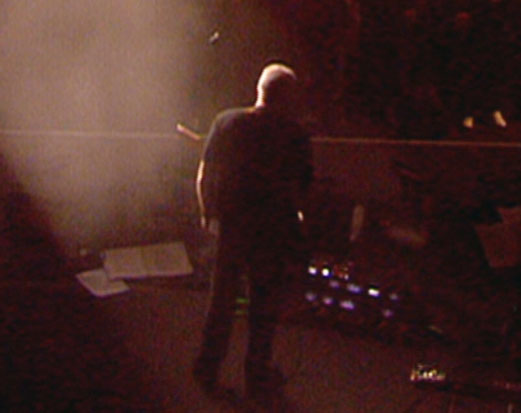
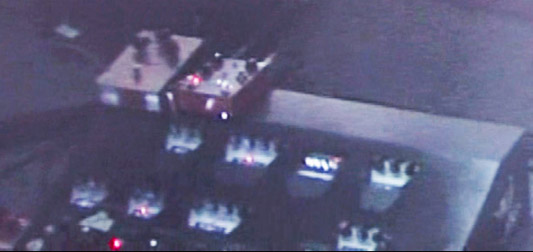
Castellorizon (audience vid)
Demeter Compulator > Dist / P-1 > Tube Driver 1 (boost) > Tape Echo Simulator (DD-2) delay was set for approx 580ms
Castellorizon (audience vid)
Demeter Compulator > Tube Driver 2 (overdrive) > Tape Echo Simulator (DD-2)
On An Island
second solo (audience vid)
Tube Driver 2 (overdrive) > Tape Echo Simulator (DD-2) > TES Bandwidth ON
On an Island (RTN)
MXR rack delay is set to 607ms during song, but not used for this song
The Blue
verse sections (RTN)
Demeter Compulator > Univibe (LED lit, but does not sound like it is on) > Tape Echo Simulator (DD-2)
The Blue
solo (audience vid)
Demeter Compulator > Octave (Whammy) > Tube Driver 2 (overdrive) > Tape Echo Simulator (DD-2) > MXR? (looks like LED is on, but difficult to see). MXR delay was set to 607ms at one part of the song and 712 during the solos, but David never adjusted it.
Shine on You Crazy Diamond
first solo (audience vid)
Demeter Compulator and delay. Could not see the delay section clearly to determine if the TES/DD-2 delay was on, but it is documented that David used the SDE 3000 delay in his Sound-on-Sound rig for this part of the song. It was was set for a 1500ms delay.
solo after first verse section
(RTN)
Demeter Compulator > Tube Driver 1(boost) > Tape Echo Simulator (DD-2)
Fat Old Sun (RTN)
MXR rack delay is set to 421ms during song. Unsure if it or TES was used
Coming Back to Life
second solo (audience vid)
Tube Driver 2 (overdrive) > Tape Echo Simulator (DD-2)
Note - Compulator LED was blocked so it may or may not have been on
Echoes (RTN)
MXR rack delay is set to 304ms during song
Find the Cost of Freedom
this song uses an acoustic guitar that does not route through the pedalboard, so these must be settings from one of the previous songs, probably Echoes
Dist (P-1) > Tape Echo Simulator (DD-2)
Comfortably Numb
verse section (RTN) not complete, just what could be seen
Dist (P-1) > Tape Echo Simulator (DD-2)
second solo (RTN) not complete, just what could be seen
Dist (P-1) > Tape Echo Simulator (DD-2) > MXR digital delay (537ms)
Comfortably Numb
second solo (audience vid)
Tube Driver 2 (overdrive) > Boss GE-7 > Tape Echo Simulator (DD-2) > MXR digital delay
Compulator LED was blocked, so unknown if it was on
Astronome Domine
Demeter Compulator > Tube Driver 2 (overdrive) > Boss GE-7 > Tape Echo Simulator (DD-2)
Echoes - I was never able to see the David's pedalboard clearly for any of the 2006 tour videos of Echoes. Since I have nearly all the same, or similar, gear David used, I made signal chains that matched the tones I hear on most of the Remember That Night and a few Gdansk songs. Below are the signal chains I think were used for Echoes.
first solo = Demeter > TD#1 > delay. Neck pickup
first verse chords = Demeter > TD#1. Neck pickup, then bridge
second solo = Demeter > TD#2 > delay. Neck pickup, then bridge
funky part chords = Demeter > TD#1. Neck pickup, then middle
third solo (in the funky part) = Demeter > Triangle Big Muff > TD#1 > Replica delay. Neck pickup
delay rhythm build up before last verse = Demeter > TD#2 > delay. Bridge pickup
heavy guitar parts after last verse = Demeter > TD#2 > delay (possibly the Triangle Big Muff used instead of TD#2 - it sounds different from the same part earlier in the song) Bridge pickup
last verse chords = Demeter > TD#1. Middle pickup
outro solo = Demeter > TD#1, delay. Neck pickup
GETTING THE TONES - Most of David's 2006 tour lead tones are a Tube Driver through a Hiwatt DR103, as heard on Remember That Night. That sound is rather easy to get with a Hiwatt DR103/504 or a clone like a Hi-Tone or Reeves.
During the European leg of the tour David added an Alessandro Redbone Special amplifier. You can hear that blended with the Hiwatt on Live in Gdansk. The two setups sound distinctly different. The Hiwatt-only setup sounds more like David's old traditional Hiwatt-into-WEM-speaker-cabinet sound, minus the modulation, while the Alessandro/Hiwatt blend has a brighter and more compressed sound, like a plexi Marshall Super Lead mixed with a Hiwatt. The Alessandro seems to be the dominant amp supplying the highs and upper mid frequencies and the Hiwatt fills out the lower end frequencies. If I had to guess at the mix, I think it was about 70% Alessandro to 30% Hiwatt. David used a similar Alessandro/Hiwatt setup for his 2015-2016 Rattle That Lock tour.
I prefer the RTN tones over the Gdansk tones, but I like a blend of both. My 59 Bassman combo sounds very similar to the Gdansk tones, so to get something in between the RTN and Gdansk tones, I blend my Bassman with a Reeves Custom 50 (Hiwatt Custom 50 clone) or a Hiwatt DR103. My Reeves or Hiwatt goes through a 4x2 speaker cab loaded with two Crescendos and two Celestion G12-75T speakers. The Bassman fills out the highs and mids and the Hiwatt the lows, making for a very full sound.
My 2006 tour high gain lead tone settings, which are similar to Gilmour's settings
One of my favorite examples of this tone is the long solos David played on his Telecaster in the song Fat Old Sun. The playing was very unique for David. He was fluently flying all over the fretboard with a barrage of double stops, chunky chord strumming, string bends, and blazing lead lines, all following the chord changes tightly in what was a very fast tempo. Fast for David anyway. He has been playing this song since the early 1970s, so he was obviously very fluent with playing leads across the chord changes easily, but I had never heard him rock out in quite this way before. The Gdansk version is particularly fiery, and I love the tone.
Below is a video of my setup for that song using this signal chain:
Demeter Compulator > Pete Cornish G-2 > BK Butler 911 Tube Driver > FTT Future Factory delay (420ms) > FTT Ambi Space plate reverb.
Effect settings are shown above. I am using a Fender American Series Telecaster with stock pickups. Even with the G-2 drive set to maximum, it does not have enough distortion to match the high gain lead tones from RTN or Gdansk through my rig, but adding the Compulator before it and the Tube Driver after it matches some of the characteristics of David's lead tone.
The clip below is the same setup as above, but I added a Boss CS-2 in front of the Demeter Compulator, and only used my 59 Bassman amp. It's very noisy running two comps together like this, but it adds more crunch and saturation to the disortion, getting even closer to the Gdansk sound to my ears.
Combining the G-2 with the Tube Driver gives the sound a slightly brighter mid range, but the Tube Driver alone works just as well. Below is a clip of just a 911 Tube Driver and delay into my Bassman amp. This tone is not quite the same as David's Alessandro RBS amp heard on Live In Gdansk, but it has a similar feel.
Below is a clip of just the Tube Driver into my Reeves, using David's 2006 tour Hiwatt settings. Alone it sounds a bit muffled and flat, but when blended with the Bassman, it fills out the lows.
![]() Fat Old Sun solo - Reeves Custom 50
Fat Old Sun solo - Reeves Custom 50
Here is both amps blended together, which has a much fuller sound
![]() Fat Old Sun solo - 59 Bassman+ Reeves Custom 50
Fat Old Sun solo - 59 Bassman+ Reeves Custom 50
__________________________________________________________
CASTELLORIZON - This is another one of my favorite lead tones from On An Island, and I really like the more aggressive tones David got when playing this live. Here is my take on the album version using two different setups through my Reeves Custom 50. I am using a Strat with a Seymour Duncan SSL5 bridge pickup and a Fat '50s neck pickup.
![]() Castellorizon - BKB 911 Tube Driver > and TC Nova delay
Castellorizon - BKB 911 Tube Driver > and TC Nova delay
![]() Castellorizon - Buffalo TD-X > TC Nova delay
Castellorizon - Buffalo TD-X > TC Nova delay
__________________________________________________________
TAKE A BREATH SOLO - I prefer the live versions of this song much more than the studio album version, especially David's solos. Here is my take on it using several different setups through a Reeves Custom 50. I used a Strat with a Seymour Duncan SSL5 bridge pickup. My favorite is the Tube Driver, but there are many alternatives that sound similar.
![]() Take A Breath solo - Demeter Compulator > Tube Works 911 Tube Driver > Future Factory Delay > Ambi Space Plate Reverb > Reeves Custom 50
Take A Breath solo - Demeter Compulator > Tube Works 911 Tube Driver > Future Factory Delay > Ambi Space Plate Reverb > Reeves Custom 50
![]() Take A Breath Solo - Demeter Compulator > Cornish P-2 > Tube Driver > Future Factory Delay
Take A Breath Solo - Demeter Compulator > Cornish P-2 > Tube Driver > Future Factory Delay
![]() Take A Breath solo Boss BD-2 Blues Driver - Boss CS-2 compressor > Boss BD-2 Blues Driver > Boss CE2-B chorus (mix at 30%) > Future Factory delay > Ambi Space plate reverb
Take A Breath solo Boss BD-2 Blues Driver - Boss CS-2 compressor > Boss BD-2 Blues Driver > Boss CE2-B chorus (mix at 30%) > Future Factory delay > Ambi Space plate reverb
![]() Take A Breath solo with EHX Hot Wax - Boss CS-2 > EHX Hot Wax > Future Factory delay > Ambi Space plate reverb
Take A Breath solo with EHX Hot Wax - Boss CS-2 > EHX Hot Wax > Future Factory delay > Ambi Space plate reverb
![]() Take A Breath solo with Buffalo TD-X - Boss CS-2 compressor > Buffalo FX TD-X > Future Factory delay > Ambi Space plate reverb
Take A Breath solo with Buffalo TD-X - Boss CS-2 compressor > Buffalo FX TD-X > Future Factory delay > Ambi Space plate reverb
![]() Take A Breath Solo - Tube Driver > EHX Civil War/Green Russian Big Muff > Future Factory Delay
Take A Breath Solo - Tube Driver > EHX Civil War/Green Russian Big Muff > Future Factory Delay
__________________________________________________________
THE BLUE - The pitch shifting Tube Driver tone of The Blue is very similar to David's sound on Marooned from The Division Bell. If anything, David's use of the DigiTech Whammy became even more smooth and eloquent on The Blue than Marooned. David used a Whammy (WH1) pedal for the studio recording and a DigiTech IPS 33B Super Harmony Machine for the live performances. The sound the octave circuit in those can be a bit glitchy if you do not play cleanly or slide the foot pedal up and down smoothly. The DigiTech Whammy 5 (WH5) that was released many years later is much smoother sounding. It still retains that classic Whammy sound, and that is what I recommend for this. David actually switched to the Whammy 5 for his Rattle That Lock tour after his WH1 broke down.
The Whammy should always go before the overdrive second in the signal chain, but it helps to have a compressor in line before the Whammy to make the sound smoother. David alwasy uses the 1 ocave up setting of the Whammy side of the parameter controls, never the Harmony side.
Below is a video using the Whammy 5. The sound is a bit thin and trebly becasue this is just an iphone mic recording, but I think you can hear how easy it is to get this tone. The Signal Chain is a Strat with EMG-DG20 pickups > Boss CS-2 compressor > Whammy 5 with 1 octave up setting - switched to classic mode > BKB Tube Driver set for a medium overdrive > TC Nova delay set for 630ms > Reeves Custom 50 amp into Hitone Eclipse 4x12 cab.
Below is a sloppy video using demonstrating the difference between the Whammy 1 and Whammy 5 pitch tracking. The WH1 tracking is audibly more glitchy sounding - meaning there are more digitatal artifacts in the sound - than the WH1, but some people prefer that sound.
__________________________________________________________
ON AN ISLAND SOLOS - This is one of David Gilmour's most superbly crafted solos, from the title song of his On and Island album. He used a Tube Driver and Hiwatt for the studio recording. When playing live he almost always used a Tube Driver, although for some performances he may have used a Cornish P-1, or possibly the Cornish G-2. It is likely David did not use the same pedal every time a song was performed, but rather chose the one he thought would sound best for the venue, and his mood at the time. Here are clips of both solos from the studio recording, with isolated parts from the 5.1 surround sound mix.
On an Island solo #1 - Isolated guitar mix without delay and reverb. Les Paul and Black Strat.
On an Island solo #2 - Isolated guitar mix without delay and reverb. Black Strat.
On an Island solo #2 - Here is the same, but what sounds like deep room reverb from another mic.
Since I was going for the live tone here, below are clips of Gilmour playing the solo live at different times from 2006 for reference
On An Island Solo #2 Clip - From Dortmund, Germany. March 10, 2006
On An Island Solo #2 Clip - From the Mermaid Theatre, London. March 6, 2006
MY ATTEMPTS - A Tube Driver through a Hiwatt is the easiest way to get this tone, and that is what sounds closest in my rig, but I found that just about any good vintage sounding Big Muff or Muff clone will give you a similar sound through a Hiwatt DR103/504, clone, or amp with a similar voice, along with a light boost a BK Butler Tube Driver. David uses some delay here, so you need a warm sounding digital or analog delay. I would stay away from using amp reverb, unless it is set very low.
Below are some older clips I made through a clean '65 Fender Twin Reverb RI, using various pedals David has used for comparison, and some alternates. My playing on most of these is very sloppy, but I think you can hear the tonal differences clearly. Signal chain: Am Std Fender Strat w/Seymour Duncan SSL5 bridge pickup > Muff (or clone) > BK Butler Tube Driver > TC Electonic Nova delay. Backing track was created by Deck, posted on The Gilmour Gear Forum, with a bit of the studio track mixed in by me. The settings on the Tube Driver, EQ, and delay are basically the same on each clip, except the Tube Driver overdrive clip, which is just the TD and some delay. Settings used are shown below.
Pete Cornish P-1 (Modified Ram's Head Big Muff clone)
Solo with backing track
Same as above but without backing track diminished, for exact tone reference
Solo with backing track. P-1 only. No Tube Driver or GE-7
Same as above but without backing track diminished, for exact tone reference
BK Butler Tube Driver overdrive - with “TUBE 2” overdrive settings from David's Cornish board (No separate EQ)
Solo with backing track
Ram's Head Big Muff - vintage
Solo with backing track
Same as above but without backing track, for exact tone reference
Pete Cornish G-2 (heavily modified Big Muff with Germanium diodes)
Solo with backing track
Same as above but without backing track, for exact tone reference
Pete Cornish P-2 (Modified Ram's Head Big Muff clone)
Solo with backing track
Same as above but without backing track, for exact tone reference
Solo with backing track. P-2 only. No Tube Driver or GE-7.
Same as above but without backing track, for exact tone reference
ALTERNATE PEDALS - Below are some clips of this solo using other Gilmourish sounding pedals. Some sound much better for this tone than others, but each have thier own unique character, so this is a good reference for the tonal differences in each pedal. The settings (pictured above) on the Tube Driver, EQ, and delay are basically the same on each clip, except the Pink Flesh, which does not require the Tube Driver boost.
Sovtek Green Big Muff
Solo with backing track
Same as above but without backing track, for exact tone reference
USA Big Muff Re-Issue (current V9 Muff)
Solo with backing track
Same as above but without backing track, for exact tone reference
Skreddy Pink Flesh (Triangle Big Muff clone with some built in boost). The Skreddy Pig Mine is another alternative for this tone.
Solo with backing track
Same as above but without backing track, for exact tone reference
B.Y.O.C. Large Beaver (Triangle Muff clone - 4 Knob Version)
Solo with backing track
Same as above but without backing track, for exact tone reference
Absolutely Analog Green Russian (Green Sovtek Big Muff clone)
Solo with backing track
Same as above but without backing track, for exact tone reference
ProCo Rat 2 (A Muffush sounding distortion)
Solo with backing track
Same as above but without backing track, for exact tone reference
Skreddy Lunar Module (Not a Muff, but more of a Fuzz Face/Overdrive type pedal)
Solo with backing track
Same as above but without backing track, for exact tone reference
RETURN TO GILMOUR TONE BUILDING HOME
Article written in 2008
Kit’s Secret Guitar, Gear, and Music Page
Guitar stuff, gear stuff, soundclips, videos, Gilmour/Pink Floyd stuff, photos and other goodies.
Copyright Kit Rae.
VISIT MY SWORDS, KNIVES and FANTASY ART WEBSITE www.kitrae.net

